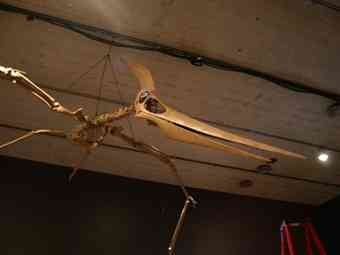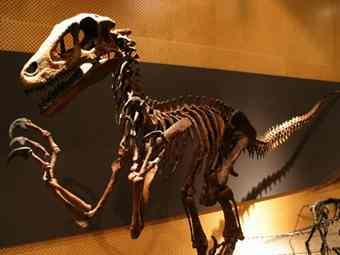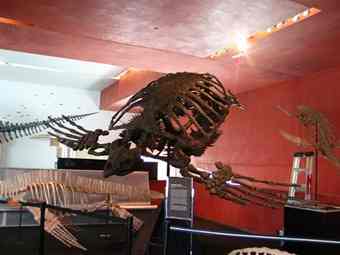If you just can't get enough of dinosaurs, then Cranbrook Institute of Science's new exhibit may be for you.
 More than 60 skeletal mounts (casts from original fossils and bones) representing 40 species of dinosaurs that once inhabited Earth between 250 and 65 million years ago, during the Mesozoic Era, make up the massive "World of Dinosaurs; Land, Sea and Air" exhibit. The display covers 6,000 square feet on two levels inside the institute.
More than 60 skeletal mounts (casts from original fossils and bones) representing 40 species of dinosaurs that once inhabited Earth between 250 and 65 million years ago, during the Mesozoic Era, make up the massive "World of Dinosaurs; Land, Sea and Air" exhibit. The display covers 6,000 square feet on two levels inside the institute.
One skeletal mount sure to grab visitors' attention is the 40-foot-long male Tyrannosaurus rex, named Stan.
Apparently, life was pretty tough for old Stan. The weary bones of this intimidating specimen indicate he had healed from a broken neck and suffered an assortment of broken bones.
 He even had teeth marks in his skull, says Stephen Pagnani, spokesman for the Cranbrook Institute of Science. The culprit was most likely other surly T. rexes, adds Pagnani. "When you stand under (Stan), it is really impressive."
He even had teeth marks in his skull, says Stephen Pagnani, spokesman for the Cranbrook Institute of Science. The culprit was most likely other surly T. rexes, adds Pagnani. "When you stand under (Stan), it is really impressive."
Pagnani says a display of a carnivorous Velociraptor (aka. raptor) and a foliage-loving Protoceratops locked in a battle to the death is pretty cool too.
 Being surrounded by all that dino-glory, he says, makes you thankful to be living in this day and age. "Humans weren't around then," he says. "It probably wouldn't have been a comfortable situation for humans if we had."
Being surrounded by all that dino-glory, he says, makes you thankful to be living in this day and age. "Humans weren't around then," he says. "It probably wouldn't have been a comfortable situation for humans if we had."
Not all of the specimens in the exhibit walked the Earth, says Pagnani. There also are the marine predators such as the sea monster-like Mosasaur, which weighed up to 20 tons. And ruling the sky are the Pterosaurs (flying reptiles) suspended above the exhibit. One such flying reptile on display is the Pteranodon, which has a 24-foot wingspan.
 "World of Dinosaurs" also provides the viewer with graphics depicting what the creatures may have looked like and brief narratives of their living environment, size, diets and possible reasons for their demise.
"World of Dinosaurs" also provides the viewer with graphics depicting what the creatures may have looked like and brief narratives of their living environment, size, diets and possible reasons for their demise.
The exhibit also includes children's activities that help them to feel like a paleontologist uncovering fossils when they try the dig box that simulates what it is like to be in the field.
"The best part about the dig box is that there is no dirt," says Pagnani. "The dirt is made up of plastic rubberize pebbles, which makes parents quite happy."
 Pagnani says another big hit with visitors is the ant colony. Scientists in search of dinosaur remnants often will check around ant colonies because busy insects sometimes unearth dinosaurs bits and pieces. "Ant colonies show how we can learn things from nature," Pagnani says.
Pagnani says another big hit with visitors is the ant colony. Scientists in search of dinosaur remnants often will check around ant colonies because busy insects sometimes unearth dinosaurs bits and pieces. "Ant colonies show how we can learn things from nature," Pagnani says.
On the second Saturday of each month (except September), from 1-4 p.m., Cranbrook will give visitors young and old the opportunity to participate in a Dino Prep Lab where they can strap-on the goggles, rev-up the air-powered pick and prep dinosaur bones that are still trapped in rock.
They also can enjoy dino-themed coloring pages and dino-puppets, touch real dino-eggs and sit on an Apatosaurus (Brontosaurus) bone.
Author: Ursula Watson | Source: The Detroit News [August 12, 2010]